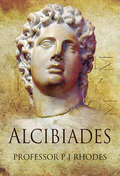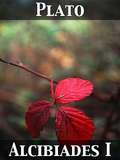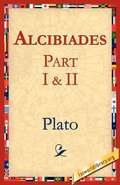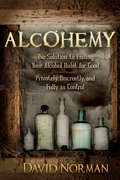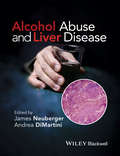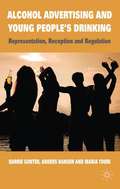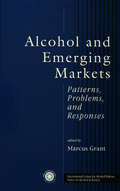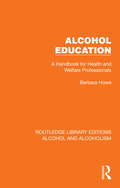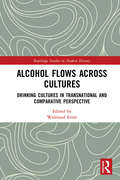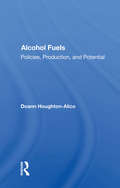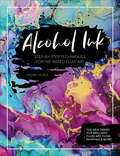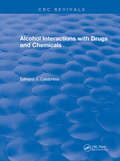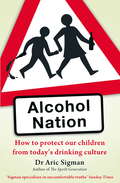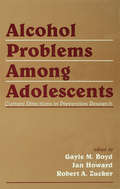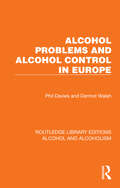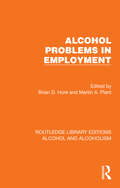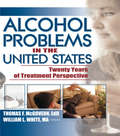- Table View
- List View
Alchymic Journals
by Evan S. ConnellCapturing the spirit of arcane writing, Evan S. Connell delivers spectacular and esoteric prose as he imagines the journals of seven alchemists. The first is Paracelsus, the famous sixteenth-century alchemist, who is followed by an array of distinct voices: physicians, historians, alchemists, and philosophers. Each employs a unique personality and point of view in a world of pre-scientific thought, of the western world about to step into modernity.Though this historical recreation is medieval in style, Connell succeeds in infusing his diarists with alchemic wisdom, ancient appeal, and felt humanness. A work of rigid art and astute mimicry, Connell's work is intelligent and remarkable, medieval yet applicable to modernity. Alchymic Journals is, at its core, a study of humanity from the mind of one of America's greatest writers.
Alchymist: The Well of Echoes, Volume Three (A Three Worlds Novel)
by Ian IrvineThe Node has failed, rendering humanity's battle clankers and the Aachim's constructs useless. With the battle lost, hordes of alien Lyrinx are swarming from the tar pits of Snizort, intending to fall upon the survivors and destroy them to the last man. Tiaan, crippled and unable to walk, is held prisoner by the vengeful Vithis, who is determined to extract her geomantic secrets at any cost. For his failings, Nish has been cast out and branded a traitor, while Irisis, accused of high treason, is forced to flee for her life. The fate of humanity is dependent on the survival of one wily old man, the Scrutator Xervish Flydd. But Flydd has been blamed for the defeat at Snizort and is condemned to die a brutish death as a slave - hauling ironclad clankers out of the battlefield mire until his heart bursts under the strain.
Alchymist: The Well of Echoes, Volume Three (A Three Worlds Novel) (Well of Echoes #Vol. 3)
by Ian IrvineThe Node has failed, rendering humanity's battle clankers and the Aachim's constructs useless. With the battle lost, hordes of alien Lyrinx are swarming from the tar pits of Snizort, intending to fall upon the survivors and destroy them to the last man. Tiaan, crippled and unable to walk, is held prisoner by the vengeful Vithis, who is determined to extract her geomantic secrets at any cost. For his failings, Nish has been cast out and branded a traitor, while Irisis, accused of high treason, is forced to flee for her life. The fate of humanity is dependent on the survival of one wily old man, the Scrutator Xervish Flydd. But Flydd has been blamed for the defeat at Snizort and is condemned to die a brutish death as a slave - hauling ironclad clankers out of the battlefield mire until his heart bursts under the strain.
Alcibiades
by P. J. RhodesWhile the Americans were fighting in Vietnam, a struggle of even greater strategic significance was taking place in the Middle East: the Sultanate of Oman guards the entrance to the Arabian Gulf, and thus controls the movement of oil from that region. In the 1960s and 70s, the Communists tried to seize this artery and, had they succeeded, the consequences for the West and for the Middle East would have been disastrous — and yet, few people have ever heard of this geo-political drama at the height of the Cold War.In the Service of the Sultan tells, first-hand, the largely unknown story of a small number of British officers who led Muslim soldiers in this hard-fought anti-insurgency war which has shaped todays Gulf. After outlining the historical, geographical and political background, the book describes military action in a stark and mountainous environment, including operations with irregular forces and the SAS as well as action in the air and at sea. The book gives a gripping, moving, funny account of all these and paints a powerful and illuminating picture of the realities of war.It will appeal to all who are interested in the Cold War and relationships between the Western and the Arab worlds. Politics, history, irregular warfare, religion, international affairs: all are ingredients in this absorbing, informative read. In the light of the current insurgencies in Iraq and Afghanistan, it is also timely to be reminded how a rare victory was won over Communist guerrillas.
Alcibiades I
by PlatoThe First Alcibiades or Alcibiades I is a dialogue featuring Alcibiades in conversation with Socrates. It is ascribed to Plato, although scholars are divided on the question of its authenticity.
Alcibiades II
by PlatoThe Second Alcibiades or Alcibiades II (Greek: Ἀλκιβιάδης βʹ) is a dialogue traditionally ascribed to Plato. In it, Socrates attempts to persuade Alcibiades that it is unsafe for him to pray to the gods if he does not know whether what he prays for is actually good or bad for him. <P> <P> There is dispute amongst scholars about the text's authenticity, and it is generally considered apocryphal.[1] The main criticisms of its authenticity revolve around its defective arguments, lack of humor, and style; those who consider it inauthentic date its composition to the 3rd or 2nd centuries BCE.
Alcoa's Bid for Alcan (A)
by Paul M. Healy Penelope RossanoIn spring 2007, Alcoa CEO Alain Belda was concerned about the company's market position in light of increased competition from developing markets. China's recent entry into the aluminum market was affecting both supply and demand. Furthermore, downstream and upstream product was coming on-line from other parts of the world, including Russia. As a result, Alcoa had lost its historical market dominance and stock premium. Belda was convinced that for Alcoa to regain its leadership position, the company would have to increase efficiencies by expanding its scale, diversification and reach. The acquisition of a large competitor presented the best opportunity to achieve this goal and, as a result, he was particularly intrigued by Canadian rival, Alcan because its assets would complement Alcoa's portfolio and enhance its reach. Further, Alcan had sold off non-aluminum assets, essentially making it a pure play in aluminum. That and its access to relatively cheap Canadian hydro power made it an even more intriguing acquisition opportunity for Alcoa. However, another major competitor, Rio Tinto, was also interested in Alcan; the company was in play.
Alcoa's Bid for Alcan (B)
by Paul M. Healy Penelope RossanoIn spring 2007, Alcoa CEO Alain Belda was concerned about the company's market position in light of increased competition from developing markets. China's recent entry into the aluminum market was affecting both supply and demand. Furthermore, downstream and upstream product was coming on-line from other parts of the world, including Russia. As a result, Alcoa had lost its historical market dominance and stock premium. Belda was convinced that for Alcoa to regain its leadership position, the company would have to increase efficiencies by expanding its scale, diversification and reach. The acquisition of a large competitor presented the best opportunity to achieve this goal and, as a result, he was particularly intrigued by Canadian rival, Alcan, because its assets would complement Alcoa's portfolio and enhance its reach. Further, Alcan had sold off non-aluminum assets, essentially making it a pure play in aluminum. That and its access to relatively cheap Canadian hydro power made it an even more intriguing acquisition opportunity for Alcoa. However, another major competitor, Rio Tinto, was also interested in Alcan; the company was in play.
Alcohemy: The Solution to Ending Your Alcohol Habit for Good: Privately, Discreetly, and Fully in Control
by David NormanAlcohemy is a proven process for anyone questioning the role of alcohol in their life. It gives you the power to succeed, revealing that alcohol doesn’t free you to be yourself, but actually limits your full potential. With Alcohemy, you can recover from the depths of despair to become the “master of your fate, and captain of your soul.” Alcohemy is a proven 13-element plan that will help you become alcohol-free based on real-life, personal experience. It will change you from the inside and deliver the outward results. You will not have to constantly resist drinking or be labeled an alcoholic for the rest of your life; the desire to drink will truly disappear. The Alcohemy process can be accomplished discreetly in the privacy of your own home. This book highlights the real cost of alcohol-related problems globally and personally and puts the power to succeed back in your hands, where it should be.
Alcohol & Tobacco
by Rosa WatersMost young adults know that alcohol and tobacco aren't good for them--but they may not know the real-life consequences of using these harmful substances. From coughing to cancer, from alcohol poisoning to problems with your liver, alcohol and tobacco can cause serious damage to your health. Smoking and drinking also do damage to your relationships with others and can land you in trouble with the police. Find out more about the dangerous consequences of alcohol and tobacco use. Discover the downside of alcohol and tobacco!
Alcohol Abuse and Liver Disease
by James Neuberger Andrea DimartiniFor people with alcohol excess and liver disease, successful management must be two-fold with management of both their psychological/physical addiction to alcohol and their liver disease. Alcohol Abuse and liver disease, with its joint focus on hepatology and psychiatry, provides both hepatologists and psychiatrists of all levels with a practical, concise and didactic guide to the investigation and clinical management of those with alcohol-related problems. Edited by a practicing hepatologist in the UK and a practising specialist in psychiatry/substance abuse in the US, it covers areas such as: * Risk factors for alcoholic liver disease * Interaction of alcohol with other co-morbidities * Clinical assessment of alcohol intake * Detoxification and management of withdrawal * Psychotherapeutic and pharmaceutical interventions * Treatment of liver disease Key points, management diagrams and high-quality images are all be supported by the very latest in clinical guidelines from the major hepatology and psychiatry societies such as the APA, EPA, AASLD and EASL. With increasing emphasis on multi-disciplinary speciality care in this area, this is the ideal tool to consult in order to provide the best care possible care for what are very challenging patients to manage.
Alcohol Addiction: Not Worth the Buzz (Illicit and Misused Drugs)
by Ida WalkerWhat's wrong with a beer now and then? Or a glass of wine with dinner? For most people--of legal age--there's absolutely nothing wrong with having an occasional drink. But for others, those with drinking problems, there's no such thing as an occasional drink. For them, one drink leads to another and another and another. . . . Alcohol Addiction: Not Worth the Buzz provides you with important information about alcohol addiction (alcoholism) and other drinking problems. You will learn about the history of alcohol use and early attempts to curb drinking, how alcohol affects the brain, and the effects it has on the body in the long and short term. This book also provides information on how individuals with alcohol problems can get help. Through first-person stories, you will learn how alcohol personally affected the lives of young people, and how they did not let alcohol addiction defeat them.
Alcohol Advertising and Young People’s Drinking
by Barrie Gunter Anders Hansen Maria TouriThere is widespread and growing concern about the use of alcohol in society, especially by young people. Although overall volumes of alcohol consumption may be levelling off, the occurrences of excessive or 'binge' drinking, especially among teenagers and young adults, are increasingly commonplace. Tackling irresponsible drinking, which is linked to other antisocial behaviour and health problems, has focused attention on the promotion of alcohol by its producers as an important causal factor. This has led to calls for tougher regulation of alcohol marketing, including restrictions on where it can occur and the form it is allowed to take. Empirical research evidence, often emanating from government funded enquiries and endorsed by health lobbies, has been cited in support of an allegedly primary role played by advertising in triggering interest in and the onset of alcohol consumption among young people and in encouraging regular and heavy drinking. Close examination of this evidence, however, reveals that the research is not always as cut and dried as it may first appear. Methodological weaknesses abound in studies of the purported effects of alcohol advertising and other forms of marketing and the significance specifically of advertising as an agent that shapes young people's alcohol consumption could be weaker than often thought. This book sets out a review and critique of the evidence on alcohol advertising and marketing effects on young people and considers this evidence in relation to codes of advertising and marketing practice.
Alcohol And Emerging Markets: Patterns, Problems, And Responses (ICAP Series on Alcohol in Society)
by Marcus GrantDivided into two parts, Alcohol and Emerging Markets begins with a series of case studies that assess alcohol issues in four regions - Asia, Central and Eastern Europe, Latin America, and Sub-Saharan Africa - and four countries - China, India, Mexico, and Russia. Issues such as past and current public policy developments, prevention programs, and treatment of alcohol related disorders are addressed as well as the health consequences of alcohol use and abuse. In the second part, the contributors consider the issues relevant to the entire geographical region covered by the book. The book also includes a chapter that examines the role of the industry in emerging markets and suggests a set of guidelines that address alcohol misuse issues.
Alcohol Education: A Handbook for Health and Welfare Professionals (Routledge Library Editions: Alcohol and Alcoholism)
by Barbara HoweAlcohol education in the 1980s was receiving greater emphasis in the training and practice of a wide range of health and welfare professionals. As we became more aware of the risks associated with excessive drinking, this practical, straightforward guide, originally published in 1989, would have been essential reading for health and welfare workers who were keen to develop the alcohol education aspect of their work and enable their clients and patients to use alcohol in a harm-free way. Barbara Howe looks at alcohol education in context, clarifying its role and place in the day-to-day work of health and welfare professionals at the time. She also discusses common myths and misunderstandings about alcohol among professionals and their clients. She describes various approaches to alcohol education and includes a series of practical exercises for use with individuals and families, aimed at increasing professionals’ confidence and competence in broaching the subject of alcohol. Although working practices may have changed since first publication, much of this title will still be useful today.
Alcohol Flows Across Cultures: Drinking Cultures in Transnational and Comparative Perspective (Routledge Studies in Modern History)
by Waltraud ErnstThis book maps changing patterns of drinking. Emphasis is laid on the connected histories of different regions and populations across the globe regarding consumption patterns, government policies, economics and representations of alcohol and drinking. Its transnational perspective facilitates an understanding of the local and global factors that have had a bearing on alcohol consumption and legislation, especially on the emergence of particular styles of ‘drinking cultures’. The comparative approach helps to identify similarities, differences and crossovers between particular regions and pinpoint the parameters that shape alcohol consumption, policies, legal and illegal production, and popular perceptions. With a wide geographic range, the book explores plural drinking cultures within any one region, their association with specific social groups, and their continuities and changes in the wake of wider global, colonial and postcolonial economic, political and social constraints and exchanges.
Alcohol Fuels: Policies, Production, And Potential
by Doann Houghton-alicoSince the 1973 OPEC oil crisis, the rise of imported crude oil prices, and the questionable availability of petroleum supplies, the United States has been forced to investigate liquid-fuel alternatives. Alcohol fuels, including methanol and ethanol, offer the most realistic near-term potential as gasoline extenders or substitutes. This book is the
Alcohol Ink: Step-by-Step Techniques for Ink-Based Fluid Art
by Desirée DelâgeMake vibrant abstract art with ink! Includes over twenty step-by-step tutorials on this colorful creative technique. Alcohol inks have exploded onto the art scene with the rise of fluid art techniques such as paint pouring. These accessible inks can be used to create stunning abstract art, even if you&’re a total beginner. Through the step-by-step tutorials and exercises in this book, you&’ll learn everything you need to know to get started with alcohol ink and how to combine techniques into bold, colorful artworks. In addition to paintings on paper, you&’ll discover inspiration and advice on using the techniques to decorate a wide range of surfaces, including ceramics, plastic, glass, wood, and more, to make fashion and home accessories and striking handmade gifts.
Alcohol Interactions with Drugs and Chemicals (CRC Press Revivals)
by Edward J. CalabreseAlcohol Interactions with Drugs and Chemicals is a concise volume that identifies, documents, and assesses the capacity of alcohol to alter the toxicity of chemical pollutants and drugs in animal models and humans. The book systematically assesses interactions according to general chemical classes of inorganic and organic agents. It also presents an integrative discussion of the significance of these findings to public health.Alcohol Interactions with Drugs and Chemicals will be a valuable reference tool for environmental scientists, toxicologists, epidemiologists, and alcohol researchers studying the interactions of alcohol with drugs and chemical pollutants.
Alcohol Nation: How to protect our children from today's drinking culture
by Dr Aric SigmanWe are a nation that loves to drink. And we're passing the habit on to our children. But a growing body of compelling new evidence about the dangers of alcohol consumption at a young age will force us to reconsider the entire way we view alcohol and young people. As parents, we need to talk to our children about alcohol but many of us are not sure what to say. In this essential book, Dr Aric Sigman ties up all the latest medical research and cultural issues and puts them into context. Most importantly he addresses drinking not just as a teenage problem but as an integral part of our history and culture. It will lead us to understand how the way we view alcohol impacts directly upon our chidlren's present and future health, wellbeing and academic success, and it will answer the question, 'how can I reconcile my enjoyment of drinking with ensuring my child grows up knowing how to drink sensibly?'.
Alcohol Problems Among Adolescents: Current Directions in Prevention Research
by Gayle M. Boyd Jan Howard Robert A. ZuckerAlcohol misuse presents a major risk for health and well-being throughout the life-span, but youth have a special vulnerability. Alcohol is the most widely used drug by adolescents. For some, this may be one or two isolated occasions of youthful experimentation; for others, the use becomes excessive, placing them in danger of immediate adverse consequences such as accidental injury and alcohol poisoning, or encouraging other high-risk behavior patterns including unprotected sex. Moreover, a pattern of heavy drinking established in adolescence and young adulthood may continue into an adult pattern of alcohol abuse. Concerned communities and institutions across the nation are tackling the problem of alcohol use and abuse by young people. Research-based knowledge is urgently needed to inform these efforts and to ensure that limited prevention resources are used as effectively as possible. The origins of youthful alcohol use and abuse are found within the complex interplay of individual characteristics, family and peer influences, the larger societal context for alcohol use, environmental conditions, and maturational processes that accompany adolescence. This volume, which began as a special issue of the Journal of Research on Adolescence, contains all of the material from the journal issue plus additional chapters. It helps researchers to meet the tremendous challenge of disentangling the key determinants of risk, and developing effective interventions. Primary sources of influence on youthful alcohol use are described, ranging from individual expectancies about alcohol effects and cognitive decision processes to parenting practices, peer influences, social environments, and economic factors; and a corresponding range of prevention interventions is discussed. This book will serve as a primer to those with an interest in developing and improving effective programs and activities to reduce alcohol-related problems among young people. For those engaged in prevention research, the text will provide useful reviews and current findings that should aid in directing future research activities.
Alcohol Problems and Alcohol Control in Europe (Routledge Library Editions: Alcohol and Alcoholism)
by Dermot Walsh Phil DaviesThe nature of alcohol problems is very diverse and the strategies adopted for minimising these vary even more. Thinking in the study of alcohol problems in the 1970s and early 1980s had focused on the public health perspective, seeking not only to lessen alcohol problems by controlling the availability of alcohol, but also to promote moderate drinking practices and to preserve the positive advantages of alcohol use. Originally published in 1983, a detailed review of public health issues in this field at the time opens the book. This is followed by an examination of alcohol-related problems and policies for their control in sixteen different European countries. The chapters on individual countries provide a source of information and data on alcohol policies, consumption and problems with which it is possible to examine from a cross-cultural and comparative basis the claims of a public health perspective. The final chapter draws together the cross-national data and discusses their implications for a public health response to alcohol problems. This book should now be a historical reference source for all interested in health policy in general and alcohol problems in particular.
Alcohol Problems in Employment (Routledge Library Editions: Alcohol and Alcoholism)
by Brian D. Hore Martin A. PlantThe majority of problem-drinkers are not unemployed derelicts but are employed persons often with senior positions in commerce, the professions and industry. Furthermore, it is well-known that alcohol causes widespread absenteeism, inefficiency and accidents at work. Originally published in 1981, Alcohol Problems in Employment reviews the evidence relating to the general effects of alcohol misuse on employment and the special problems involved in certain ‘high-risk’ industries at the time. A number of international case studies are then presented to illustrate what was being done to counter the problem.
Alcohol Problems in the Community
by Larry HarrisonCommunity surveys reveal that about 6% of the adult male and 1% of the adult female population in England and Wales are drinking at high risk levels. Alcohol Problems in the Community examines the implications of recent community care legislation for government policy on alcohol. The first part of the book begins with a report on recent US research on the role of alcohol in the perpetration of child abuse and recent research on young people's drinking problems. This is followed by a study on the prevalence of drinking problems amongst older people which has been underestimated. In the second half of the book empirical evidence is presented on the particular difficulties faced by ethnic, migrant and homeless groups and this emphasis on the centrality of social disadvantage leads on to a consideration of a specific social work role in the assessment and management of alcohol-related problems. Alcohol Problems in the Community is aimed at social work practitioners and students on prequalifying, qualifying and postqualifying social work courses, and it addresses key social work issues in relation to poverty, homelessness, discrimination and drinking problems.
Alcohol Problems in the United States: Twenty Years of Treatment Perspective
by William White Thomas F McgovernAlcohol Problems in the United States: Twenty Years of Treatment Perspective presents an overview of trends in the treatment of alcohol problems over a 20-year period from three vantage points: broader treatment perspectives, experienced views from the field, and personal perspectives. Some of the field's foremost experts, including Alcoholics Anonymous historian Dr. Ernest Kurtz and Dr. Robert Sparks, who chaired the committee that authored the Institute of Medicine&’s highly influential study, "Broadening the Base of Treatment for Alcohol Problems," provide practical information on the vital treatment issues you deal with every day. By detailing treatment histories of the recent past, contributors offer a look at likely future trends that will help keep your treatment methods up to date. Treatment topics addressed in Alcohol Problems in the United States: Twenty Years of Treatment Perspective include: alcoholism as a disease alcohol dependence and mental illness the role of spirituality the growth and decline of treatment programs at the Mayo Clinic and Timberlawn Hospital and the special treatment needs of women, youths, African Americans, Native Americans, the Latino community, and the incarcerated. Alcohol Problems in the United States: Twenty Years of Treatment Perspective chronicles the story of alcohol treatment from historical and personal perspectives, offering the opportunity to anticipate future trends in the many challenges associated with alcohol problems. The book is an essential resource for professional alcoholism counselors, social workers, psychologists, physicians, clergy, nurses, employee assistance professionals, and anyone who provides care and service to those struggling with alcohol.


